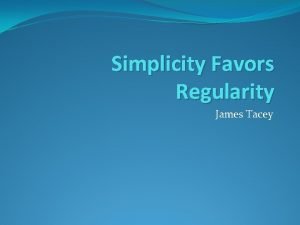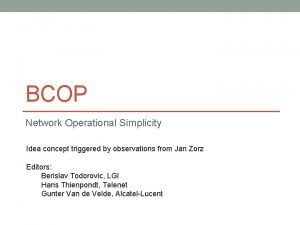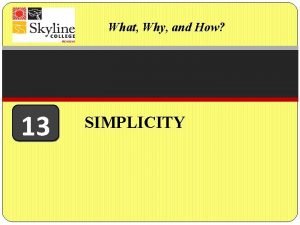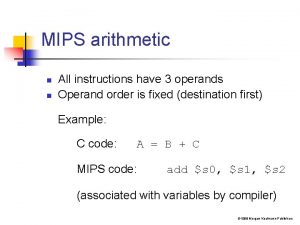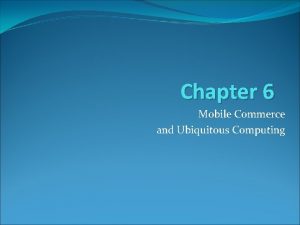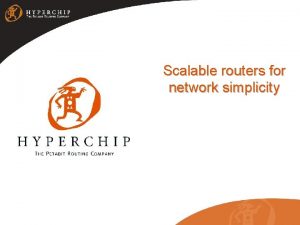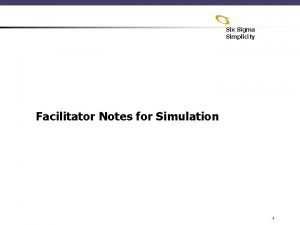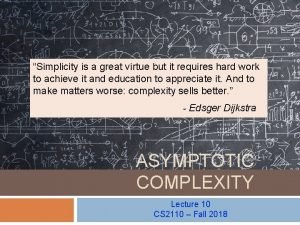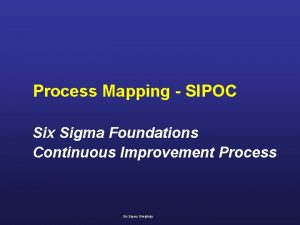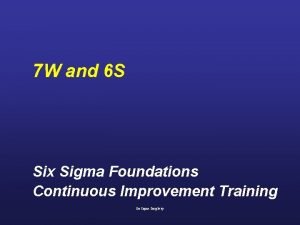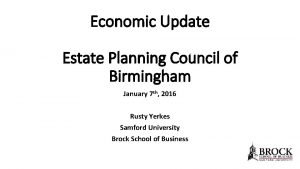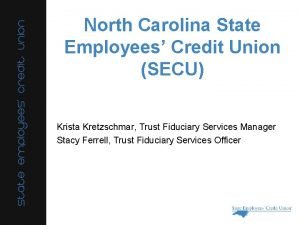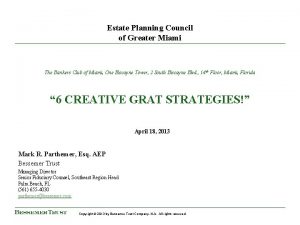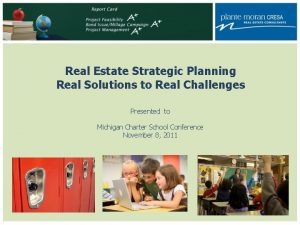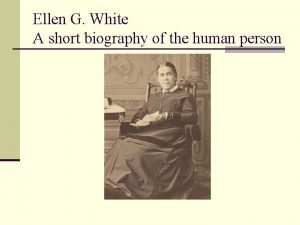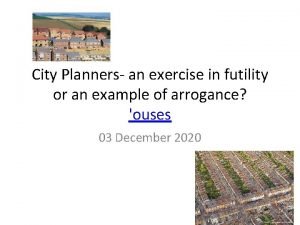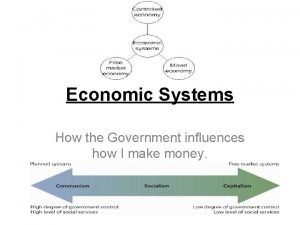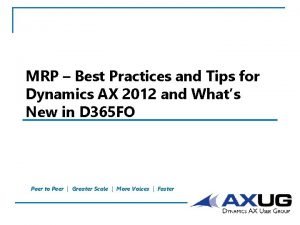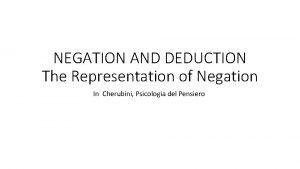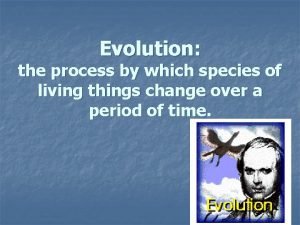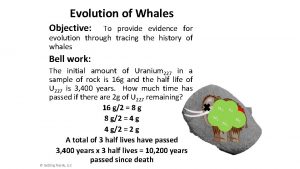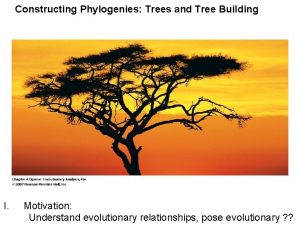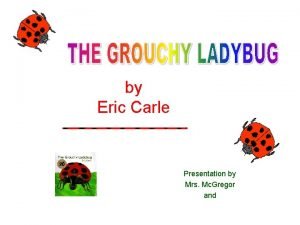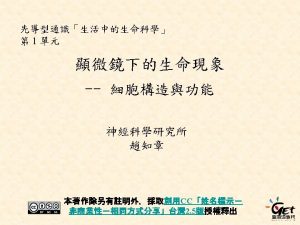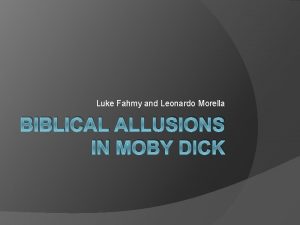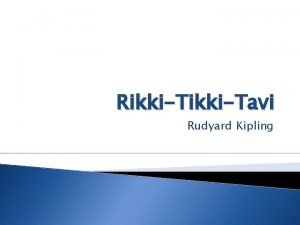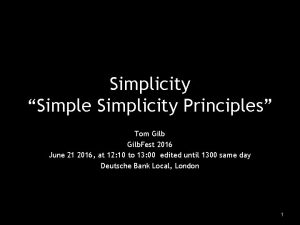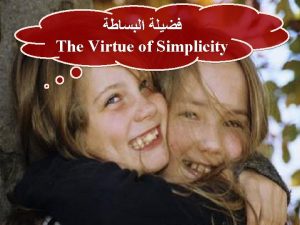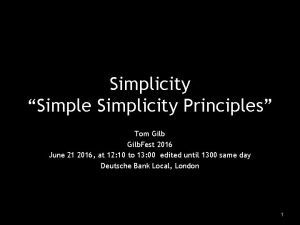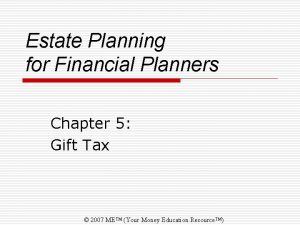SIMPLICITY THE ESTATE PLANNERS WHITE WHALE PLANNING IDEAS





















































































































- Slides: 117

SIMPLICITY – THE ESTATE PLANNER’S “WHITE WHALE”: PLANNING IDEAS FOR THE (CURRENTLY) NON-TAXABLE ESTATE Presented By: BRETT T. BERLY AND KAILI E. CUSACK brett. berly@chamberlainlaw. com kaili. cusack@chamberlainlaw. com CHAMBERLAIN, HRDLICKA, WHITE, WILLIAMS & AUGHTRY, P. C. HOUSTON 1200 Smith Street, 14 th Floor Houston, TX 77002 -4496 (713) 658 -1818 (800) 342 -5829 ATLANTA © Chamberlain, Hrdlicka, White, Williams & Aughtry, P. C. 2018 PHILADELPHIA SAN ANTONIO

INTRODUCTION § Under the Tax Cut and Jobs Act, the basic exclusion amount increased to $11, 180, 000 ($22, 360, 000 for couple). § The increase in the basic exclusion amount applies to estates of decedents dying after December 31, 2017 and before January 1, 2026.

INTRODUCTION § Possible Planning Implications: § Greater emphasis on income tax/basis planning § Reduced interest in traditional estate tax planning § Transitory nature of higher exemption highlights need for flexibility in the plan

INTRODUCTION § Elaine and Kramer married in 2012. Elaine is an executive at a catalog publishing company who dreams of owning her own dance studio. Kramer is a suspiciously successful former soap opera stand-in. Their estate, consisting primarily of a home in River Oaks, Houston, a vacation home on Lake Travis, cash, and a brokerage account, all with a current value of $14 million. § Elaine and Kramer want to prepare new Wills which leave their estate to the surviving spouse.

Traditional Techniques

Traditional Estate Planning § BYPASS TRUST & PECUNIARY MARITAL GIFT § Traditional plans would provide for a formula marital gift and with the exemption amount passing to a Bypass Trust. § The Bypass Trust allows the estate of the deceased spouse to be available for use by the surviving spouse and children while sheltering these assets from being included in the estate of the surviving spouse.

Traditional Estate Planning § BYPASS TRUST & PECUNIARY MARITAL GIFT Prior to 2018 Estate $7 mm Marital Trust $1. 51 mm Bypass Trust $5. 49 mm

Traditional Estate Planning Does the Bypass Trust continue to provide some benefits in light of a higher exemption? § Benefits 1. Control Ø Control over who the assets will ultimately be distributed to as well as aspects of administration during the surviving spouse’s lifetime. 2. Creditor Protection Ø Generally, assets are protected from creditors of the surviving spouse.

Traditional Estate Planning 3. Divorce Protection Ø Assets are protected from community property claims if the surviving spouse remarries. 4. GST Exemption Ø The deceased spouse can allocate his or her remaining generation skipping transfer tax exemption amount to the Bypass Trust. 5. Estate Tax Benefit Ø The assets may appreciate during surviving spouse’s lifetime.

Traditional Estate Planning • Disadvantages 1. Loss in Basis Adjustment Ø One major disadvantage for the Bypass Trust is that the assets in the Bypass Trust will not receive an increase in the basis.

Traditional Estate Planning • Disadvantages 2. Lack of Flexibility Ø An estate plan that leaves all of the estate to a Bypass Trust (in its traditional form) offers the surviving spouse very little opportunity to change the estate plan if circumstances or tax laws change. In contrast to other planning options such as the Clayton QTIP Trust and an outright gift coupled with a disclaimer Bypass Trust.

Traditional Techniques and an Eye to Flexibility

Traditional Estate Planning With an Eye to Flexibility OUTRIGHT BEQUEST WITH PORTABILITY ELECTION � Elaine dies in 2020 with an estate of $7 million. Elaine leaves $500, 000 to each of their children, Jerry, George and Newman, and leaves the remainder of her estate to Kramer. Her taxable estate is $1, 500, 000. The Executor of Elaine’s estate timely files an estate tax return electing portability.

Traditional Estate Planning With an Eye to Flexibility � OUTRIGHT BEQUEST WITH PORTABILITY ELECTION �Benefits of Outright Bequest �Simplicity �Avoids the administrative costs and burdens of administering a trust �Assets will have a new basis at the death of the second spouse. �Disadvantage � No estate tax protection. � One solution is portability election.

Traditional Estate Planning With an Eye to Flexibility �Example Cont. � After inheriting Elaine’s estate outright, Karmer has a total estate of $12, 500, 000. With a portability election, he effectively inherits her unused exemption amount so that Kramer now has a total exemption amount of $20, 860, 000.

Traditional Estate Planning With an Eye to Flexibility �Example Elaine $7 million $500, 000 exemption Jerry $500, 000 exemption George $500, 000 exemption Newman $500, 000 $9, 680, 000 unused exemption Kramer $12, 500, 000 (Elaine’s $5, 500, 000 + his $7, 000) $11, 180, 00 0 exemption

Traditional Estate Planning With an Eye to Flexibility �Disadvantages 1. File an Estate Tax Return and Compute the DSUE Amount Ø The Executor must timely file an estate tax return and determine the amount of the unused exemption. 2. Loss of GST Exemption Ø The surviving spouse does not “inherit” the deceased spouse’s unused generation skipping transfer tax exemption amount.

Traditional Estate Planning With an Eye to Flexibility �Disadvantages 3. Lack of Indexing Ø Although the estate and gift tax exemption amount may increase from inflation adjustments over the surviving spouse’s lifetime, the unused exemption amount for which the portability election was made will not be indexed for inflation.

Traditional Estate Planning With an Eye to Flexibility �DISCLAIMER BYPASS TRUST �One possibility for adding flexibility to the outright bequest is to include a disclaimer Bypass Trust. �The disclaimer Bypass Trust allows the surviving spouse to take a second look at the estate plan if circumstances or assets change from the date the Wills were signed until the date the first spouse dies. �The disclaimer Bypass Trust may also be coupled with a QTIP Trust.

Traditional Estate Planning With an Eye to Flexibility �Example �At the time Elaine and Kramer signed their Wills in 2012 their estate was worth $14 million. They decided they wanted the simplicity of an outright bequest. However, instead of relying solely on portability, they wanted to include an option for the surviving spouse to leave all or a portion of the estate to a trust. Therefore, they include language in their Wills allowing the surviving spouse to disclaim all or a portion of the residue of the Estate and such disclaimed portion would pass to a Bypass Trust.

Traditional Estate Planning With an Eye to Flexibility �Example cont. �Kramer dies in 2020. Between the time Elaine and Kramer signed their Wills and the time Kramer died, their home in Houston and vacation home on Lake Travis appreciated in value. Kramer's estate, once $7 million, has now grown to $12 million.

Traditional Estate Planning With an Eye to Flexibility �Example cont. �Option 1: If Elaine inherits all of Kramer's estate outright, Elaine would have an estate worth $24 million. Elaine could make a portability election and potentially shield $22, 360, 000 from estate tax. However, this still leaves Elaine with a slightly taxable estate. In addition, if the estate tax exemption amount decreases, Elaine may have a very large taxable estate. �Option 2: Elaine can disclaim all or a portion of Kramer's estate which will pass into the Bypass Trust. As stated earlier, the assets in the Bypass Trust will be excluded from Elaine's estate.

Traditional Estate Planning With an Eye to Flexibility Option 1 Kramer's Estate Option 2 Kramer's Estate 100 % Elaine Total Estate: $24 million Elaine Total Estate: $12 million Disclaimer Bypass Trust Assets: $12 million

Traditional Estate Planning With an Eye to Flexibility �DISCLAIMER BYPASS TRUST �Potential Disadvantages and Issues with Comply 1. law and Chapter 240 the of. Texas Property Code in order to be a valid and non-taxable disclaimer. 2. No Power of Appointment o The surviving spouse cannot have a power of appointment over the disclaimer Bypass Trust.

Traditional Estate Planning With an Eye to Flexibility § QTIP TRUST § Another option for a couple who wants to leave his or her estate to the surviving spouse in trust is the QTIP Trust. § The QTIP Trust offers many of the same advantages of the Bypass Trust.

Traditional Estate Planning With an Eye to Flexibility § Example § Elaine wants to leave her entire estate to Kramer but wants her estate to ultimately pass to her two children. Before her death, she has a growing concern that Kramer will leave a significant portion of their estate to Peterman instead of their children. Therefore, she decides to leave her estate to Kramer in a QTIP Trust. Kramer will be the sole beneficiary of the trust during his lifetime but at his death the assets will be distributed to their children.

Traditional Estate Planning With an Eye to Flexibility § All to QTIP-able Trust Plan – Non-Taxable Estate $7 mm QTIP-able Trust $7 mm

Traditional Estate Planning With an Eye to Flexibility § All to QTIP-able Trust Plan – Taxable Post-2025 Estate $7 mm QTIP-able Trust QTIP Portion $1 mm Non-QTIP Portion $6 mm

Traditional Estate Planning With an Eye to Flexibility § Benefits 1. Control, Creditor Protection, and Divorce Protection Ø As with the Bypass Trust, the deceased spouse can ultimately control who the assets will be distributed to at the death of the surviving spouse.

Traditional Estate Planning With an Eye to Flexibility § Benefits 2. GST Exemption Ø A “reverse QTIP election” can be made so that the deceased spouse can allocate his or her generation skipping transfer tax exemption to the trust. Ø Because a partial reverse QTIP election is not allowed, a separate reverse QTIP Trust may need to be created in order to fully utilize the generation skipping transfer tax exemption of both spouses.

Traditional Estate Planning With an Eye to Flexibility § Benefits 2. New Basis Ø One of the benefits that the QTIP Trust provides that the Bypass Trust does not is a basis adjustment at the death of the second spouse.

Traditional Estate Planning With an Eye to Flexibility § Disadvantages 1. Income Must Be Distributed to the Surviving Spouse § In contrast to the Bypass Trust, in order for the QTIP trust to qualify for the marital deduction, all income must be distributed to the surviving spouse at least annually. This potentially limits the ability of the surviving spouse to have the income taxed to a child or even the trust if the surviving spouse is in a higher income tax bracket.

Traditional Estate Planning With an Eye to Flexibility § Disadvantages 2. File Estate Tax Return § The executor of the deceased spouse’s estate must make the appropriate election by filing a federal estate tax return for QTIP treatment to apply to the trust.

Traditional Estate Planning With an Eye to Flexibility �CLAYTON QTIP �No lifetime power of appointment? �Section 2056(b)(7)(B)(ii) of the Code states that in order to qualify for the marital deduction no person can have the power to appoint any part of the property of the QTIP Trust to any person other than the surviving spouse.

Traditional Estate Planning With an Eye to Flexibility �CLAYTON QTIP �Exception �The Clayton QTIP election allows part of a marital gift which is not elected to qualify for the marital deduction to pass to another trust or different beneficiaries without jeopardizing the QTIP election.

Traditional Estate Planning With an Eye to Flexibility �CLAYTON QTIP �Example �Elaine, still concerned that Kramer will leave a portion of their estate to Peterman, wants to leave her estate in a trust for Kramer's benefit. �The home on Lake Travis, which was purchased for $1, 000, has appreciated in value to $2, 000. Their home in River Oaks, which was purchased for $3, 000, has appreciated in value to $5, 000.

Traditional Estate Planning With an Eye to Flexibility �CLAYTON QTIP �Example �Elaine does not want her children to have a large capital gain if they decide to sell these properties. Therefore, she wants to leave her estate to a QTIP Trust. However, Elaine is concerned that the estate tax will sunset in 2025 and Kramer will have a taxable estate.

Traditional Estate Planning With an Eye to Flexibility �CLAYTON QTIP �Example �To address her concerns, Elaine's Revocable Trust includes the following language: “If Kramer survives me, to the extent my Independent Trustee, in my Independent Trustee’s sole discretion, elects for all or some part of my estate to qualify for the federal estate tax marital deduction, I direct that my estate shall be divided into two portions:

Traditional Estate Planning With an Eye to Flexibility �CLAYTON QTIP �Example �Portion 1: The first portion shall consist of the share of my estate, if any, with respect to which my executor makes the election under Section 2056(b)(7) of the Code to apply. This share shall be held in the QTIP Trust under Article III of this Trust Agreement and Kramer shall be the sole beneficiary of this trust during his lifetime.

Traditional Estate Planning With an Eye to Flexibility �CLAYTON QTIP �Example �Portion 2: The second portion shall consist of all of the remaining property of my estate, if any, which does not pass pursuant to Portion 1 which shall be held and administered in the Bypass Trust under Article IV of this Trust Agreement. Kramer shall be the primary beneficiary of this trust and my descendants shall be the secondary beneficiary of this trust.

Traditional Estate Planning With an Eye to Flexibility � CLAYTON QTIP � Benefits 1. Flexibility Ø Similar to the disclaimer Bypass Trust, the Clayton QTIP election allows the surviving spouse to have a second look at the estate plan at the death of the first spouse. Ø If Elaine's estate has appreciated at the time of her death and her estate plus the value of Kramer's estate would leave Kramer with a taxable estate, the Independent Trustee can elect to have a portion of Elaine's estate pass to the Bypass Trust.

Traditional Estate Planning With an Eye to Flexibility �CLAYTON QTIP �Benefits 1. Flexibility Ø The surviving spouse may prefer the terms of the Bypass Trust over the QTIP Trust. For example, the Bypass Trust may have broader terms or additional beneficiaries (i. e. , descendants).

Traditional Estate Planning With an Eye to Flexibility �CLAYTON QTIP �Benefits 2. Power of Appointment Ø In contrast to the disclaimer Bypass Trust, because the surviving spouse is not disclaiming any portion of the estate, the Bypass Trust may include a power of appointment.

Traditional Estate Planning With an Eye to Flexibility � CLAYTON QTIP � Benefits 3. Additional Time to Elect Ø For federal tax law purposes, a disclaimer must be made within 9 months of the decedent’s death. Ø The QTIP election is made on the federal estate tax return which may give the executor up to 15 months to decide whether and to what extent to make the QTIP election.

Traditional Estate Planning With an Eye to Flexibility �CLAYTON QTIP �Potential Issues and Disadvantages 1. Surviving Spouse as Electing Party Ø It is generally recommended that the surviving spouse not be the party deciding whether and to what extent to make the election. Ø This may open up the surviving spouse to gift tax exposure.

Traditional Estate Planning With an Eye to Flexibility � CLAYTON QTIP � Potential Issues and Disadvantages 2. Electing Party as Executor Ø Texas does not recognize “special executors” so it is recommended that utilize the Clayton QTIP election in a revocable trust where trustees may be granted different powers. Ø Note that these concerns may not apply in the situation where all of the estate passes to a QTIP Trust and the executor make a partial election because the surviving spouse’s beneficial interest is the same either way.

Planning for Change

Planning for Change �BASIS ADJUSTMENT PLANNING �As stated earlier, the Bypass Trust has been used to shelter the estate of the first spouse to die from estate tax exposure at the death of the second spouse. The potential disadvantage is that this avoidance of estate tax also avoids a basis adjustment at the death of the second spouse. �There are two ways to incorporate income tax planning with the use of the Bypass Trust.

Planning for Change �BASIS ADJUSTMENT PLANNING 1. Contingent General Power of Appointment Example: Elaine dies in 2020. Elaine’s Will creates a Bypass Trust for Kramer which includes a provision that states that the assets of the Bypass Trust will be included in Kramer’s estate if, and to the extent, he has sufficient estate tax exemption (the contingent general power of appointment). Elaine has sufficient GST exemption to allocate to the trust so that it has an inclusion ratio of zero.

Planning for Change �BASIS ADJUSTMENT PLANNING 1. Contingent General Power of Appointment Ø The mere possession of a general power of appointment will cause property that is subject to the power to be included in the estate of the power holder. Thus, whether the surviving spouse exercises the power or not, the property subject to the power will get a basis adjustment.

Planning for Change �BASIS ADJUSTMENT PLANNING 1. Contingent General Power of Appointment Ø While a general power of appointment could be included over all of the assets of the Bypass Trust, a couple may feel uncomfortable with granting the surviving spouse such a broad power or subjecting all of the assets to estate tax exposure. Ø Thus, a testamentary general power of appointment based on a formula may be used.

Planning for Change � BASIS ADJUSTMENT PLANNING 1. Contingent General Power of Appointment Ø Considerations for Formula Ø GST Consequences Ø A person holding a general power of appointment will become the transferor when the property over which the power applies is subject to an estate or gift tax. The transferor is the person who must allocate GST exemption to shelter the transfer from taxation. Ø Be careful that the exercise of the general power of appointment does not cause an exempt trust to lose its exempt status.

Planning for Change �BASIS ADJUSTMENT PLANNING 1. Contingent General Power of Appointment Ø Considerations for Formula Ø Applicable Assets Ø The general power of appointment should encompass only those assets that would benefit from a step-up in basis and, if the total value of those assets exceeds the size of the general power of appointment, only those assets that would benefit the most from a step-up in basis.

Planning for Change �BASIS ADJUSTMENT PLANNING 1. Contingent General Power of Appointment Ø Considerations for Formula Ø Applicable Assets Ø For example, assets that have a greater amount of built-in appreciation or assets which would be subject to a higher tax rate. Ø Certain assets may be excluded, for example assets that are not likely to be sold like a family ranch.

Planning for Change � BASIS ADJUSTMENT PLANNING 1. Contingent General Power of Appointment Ø Considerations for Formula Ø Independent Party Ø A spouse may feel more comfortable having an independent third party decide whether and to what extent to exercise the power of appointment. Ø Caution: If a third party is granted the power to consent to the exercise of the power of appointment, this consent must be provided by a non-adverse party. See Treas. Reg. § 20. 20413(c).

Planning for Change � BASIS ADJUSTMENT PLANNING 1. Contingent General Power of Appointment Ø Considerations for Formula Ø Limit Class of Appointees Ø The power of appointment could be limited to certain classes of persons or could specifically exclude certain classes of people, i. e. descendants of the surviving spouse (particularly in the case of blended families) (but still including those parties which make it a general power of appointment, i. e. the decedent, the decedent’s estate, the creditors of the decedent’s, or the creditors of the decedent’s estate). Ø For example, the surviving spouse shall have the general power to appoint the remaining trust property to her creditors or the creditors of her estate; however, such creditors such not include the descendants of the surviving spouse.

Planning for Change �BASIS ADJUSTMENT PLANNING 1. Contingent General Power of Appointment Ø Potential Issues and Disadvantages Ø Creditors Ø Property subject to the general power of appointment may be subjected to claims of creditors.

Planning for Change �BASIS ADJUSTMENT PLANNING 1. Contingent General Power of Appointment Ø Potential Issues and Disadvantages Ø “Step-down” in basis Ø If property subject to the power has depreciated in value, the basis may be reduced.

Planning for Change �BASIS ADJUSTMENT PLANNING 1. Contingent General Power of Appointment Ø Potential Issues and Disadvantages Ø Too many restrictions on the exercise Ø A power of appointment that includes numerous restrictions on how and when the power can be exercised is subject to an argument that the power is not in fact a general power of appointment.

Planning for Change �BASIS ADJUSTMENT PLANNING 1. Contingent General Power of Appointment Kramer dies in 2025. Kramer’s estate is valued at $4 million. Kramer has $10 million of his gift and estate tax exemption amount remaining at his death. The Bypass Trust is valued at $14 million at Kramer’s death. The contingent general power will be exercised such that $6 million of the assets are included in Kramer’s estate.

Planning for Change �BASIS ADJUSTMENT PLANNING 2. Delaware Tax Trap Ø Section 2041(a)(3) of the Code provides that to the extent a power of appointment is exercised to create another power of appointment which can be exercised as to postpone the vesting of an interest for a period longer than the original rule against perpetuities, a taxable event will occur.

Changing the Plan After Death

Changing the Plan �Kramer's primary goal when he was drafting his new Will was avoidance of the estate tax. Fearing that the estate tax would sunset and he would be left with a taxable estate, Kramer decided he wanted all of the residue of his estate to pass to a Bypass Trust. Kramer dies in 2024. �As it turns out, Congress passes a new bill which keeps the estate and gift tax exemption amount at $10 million (indexed for inflation).

Changing the Plan � With Kramer and Elaine's estate valued at $14 million and a combined exemption amount of over $20 million, it is unlikely that their estate will be taxable. � Elaine is also concerned that the River Oaks home and Lake Travis property will carry with them a high income tax cost if they don’t receive a second step-up in basis. � Elaine doesn’t like the costs and responsibilities to maintain a trust. If she cannot avoid funding the trust, she wants to change the terms of the trust to accomplish her tax objectives.

Changing the Plan � One option is to fund the Bypass Trust then distribute the assets to the surviving souse. � Potential Issues: 1. The distribution must meet the distribution standard in the Will or Trust Agreement which is likely health, education, maintenance and support. Thus, for a very large trust it may be difficult to qualify a large distribution as a HEMS distribution. 2. If the trust assets are distributed disproportionately to surviving spouse, it could be argued that the remainder beneficiaries are making a gift to the surviving spouse by essentially giving up their interest in the trust. The issue with this is that valuing the interest that the remainder beneficiaries are giving up may be difficult.

Changing the Plan Other Options: 1. Modification � Section 112. 054 of the Texas Property Code governs modifications. � Section 112. 054(a)(4) allows a trustee or beneficiary to bring suit to modify the terms of the trust if the modification is necessary to achieve the settlor’s tax objectives and is not contrary to the settlor’s intentions. � This may mean that you have to prove what the settlor’s tax objectives were.

Changing the Plan 1. Modification �While Section 112. 054(a) allows a Texas court to modify a trust in order to achieve the settlor’s tax objectives, federal courts are not required to accept a modification or the retroactive effect of such a modification, absent a decision of the state’s highest court.

Changing the Plan 2. Reformation �While modifications and reformations are similar, reformations are generally based on mistakes of fact at the inception of the trust not a deviation of trust terms due to a change in circumstances. �Thus, this is probably not the best option if filing a suit to change the terms of the trust for tax reasons.

Changing the Plan 3. Decanting �If a trust agreement does not prohibit decanting, an authorized trustee may distribute principal of one trust to a second trust. �The trustee’s power to decant differs depending on whether the trustee has limited or full discretion.

Changing the Plan 3. Decanting �Beneficiary consent is not required as long as the written statutory notice is provided to all current and presumptive remainder beneficiaries. �Presumptive remainder beneficiary means a beneficiary of the trust who on that date would be eligible to receive distributions from the trust if the trust terminated on that date or the interests of all current beneficiaries ended on that date without causing the trust to terminate.

Changing the Plan 4. Termination � The statutory authority for a court to terminate a trust is similar to the statutory authority authorizing a court to modify a trust with the addition that a court may order that a trust be terminated if continuance of the trust is not necessary to achieve any material purpose of the trust or the order is not inconsistent with a material purpose of the trust. � The court may not enter an order terminating a trust for this purpose unless all beneficiaries of the trust have consented to the order or are deemed to have consented.

Changing the Plan 4. Termination �One benefit of a termination proceeding over an agreement to terminate a trust is that the court may release the trustee from liability if the beneficiaries are reluctant to sign a release.

Changing the Plan 5. Family Settlement Agreement �Beneficiaries under a Will may enter into agreements regarding the distribution of the estate as long as these agreements do not infringe the rights of others or violate a rule of public policy. �It is not necessary under the agreement that the beneficiaries receive property of equal value to that which he or she would have received under the Will in order for the agreement to be valid.

Changing the Plan 5. Family Settlement Agreement �However, for tax purposes, if the agreement changes the tax burden of the beneficiaries then it must be the result of a bona fide dispute between the parties.

Changing the Plan Federal Tax Issues

Changing the Plan FEDERAL TAX ISSUES 1. Gift Tax Risk of Modification, Agreement, Decanting and/or Termination q Shifting Beneficial Interests �A beneficiary of a trust who agrees to a trust modification for less than full and adequate consideration which has the effect of shifting beneficial interests to another person may be deemed to have made a taxable gift.

Changing the Plan FEDERAL TAX ISSUES 1. Gift Tax Risk of Modification, Agreement, Decanting and/or Termination Example: �With the exemption amount at $11. 18 million, Kramer decides that he wants to use a portion of his exemption amount before it sunsets. Therefore, he creates a trust for his children, Jerry, George, and Newman, and transfers $6 million to the trust.

Changing the Plan FEDERAL TAX ISSUES 1. Gift Tax Risk of Modification, Agreement, Decanting and/or Termination Example Cont. � The trust provides for all income to be paid in equal shares to Jerry, George, and Newman for their life. Upon the death of the first child, one-third of the remaining trust principal would be paid to that child’s descendants. Upon the death of the second child, one -half of the remaining trust property would be paid to that child’s descendants. Upon the death of the third child, the remaining trust property would be paid to that child’s descendants.

Changing the Plan FEDERAL TAX ISSUES 1. Gift Tax Risk of Modification, Agreement, Decanting and/or Termination Example Cont. � 5 years after Kramer creates the trust, Jerry is struck by a falling marble rye that leaves him permanently disabled. As a result, Jerry's cost of living greatly increases because he has to pay Dr. Wexler to help him with his daily activities. � George and Newman want Jerry to be able to receive a greater share of the income to help cover his medical expenses. Therefore, they petition the court for modification of the trust. The court approves the modification which provides for one-half of the income to be distributed to Jerry and the other one-half to be distributed to George and Newman equally.

Changing the Plan FEDERAL TAX ISSUES 1. Gift Tax Risk of Modification, Agreement, Decanting and/or Termination Example Cont. �This modification shifts the beneficial interests in the trust which is a transfer by George and Newman to Jerry for gift tax purposes. See Treas. Reg. § 26. 2601 -1(b)(4)(i)(e), Ex. 7.

Changing the Plan FEDERAL TAX ISSUES 1. Gift Tax Risk of Modification, Agreement, Decanting and/or Termination Example 2 � Kramer created a trust for his then living children, Jerry and George, and any after-born or adopted children. Newman was born after the trust was created and became an additional beneficiary of the trust. The trust was held in three separate shares with each child being the primary beneficiary of his share. � The trust provided that all net income was to be distributed to the primary beneficiary at least annually and principal for HEMS.

Changing the Plan FEDERAL TAX ISSUES 1. Gift Tax Risk of Modification, Agreement, Decanting and/or Termination Example Cont. �Jerry, George and Newman entered into an agreement that modified the trust terms. The modification provided that the trustee was given the discretion to distribute income for HEMS and any accumulated net income was to be set aside and, if not distributed to the primary beneficiary during his lifetime, it would distributed to the estate of the primary beneficiary.

Changing the Plan FEDERAL TAX ISSUES 1. Gift Tax Risk of Modification, Agreement, Decanting and/or Termination Example Cont. �The proposed modification would not result in shifting of beneficial interests because the accumulated income will be included in the primary beneficiary’s estate. PLR 201320004.

Changing the Plan FEDERAL TAX ISSUES 1. Gift Tax Risk of Modification, Agreement, Decanting and/or Termination �Kramer dies in 2020. All of Kramer’s estate passes to a Bypass Trust. The Bypass Trust provides that income and principal may be distributed to Kramer and their children for HEMS. At Kramer’s death, the remaining property passes to their children. �With Kramer and Elaine's combined estate valued at $7 million and an exemption amount of over $11, Elaine would like to terminate the Bypass Trust.

Changing the Plan FEDERAL TAX ISSUES 1. Gift Tax Risk of Modification, Agreement, Decanting and/or Termination �Although discretionary, the children have a present interest in the trust as well as a remainder interest. �The relinquishment of this interest through the proposed early termination of the trust, may constitute a transfer by children for federal gift tax purposes to Kramer.

Changing the Plan FEDERAL TAX ISSUES 1. Gift Tax Risk of Modification, Agreement, Decanting and/or Termination � Suppose George transferred his interest in the trust to his fiancé, Susan Ross. Would this be a gift? Is the result different if he transfers his interest to his father? � Other potential issues: �Fiduciary liability issues for Trustee �Should you have the children sign an agreement? Will this constitute consent?

Changing the Plan FEDERAL TAX ISSUES 1. Gift Tax Risk of Modification, Agreement, Decanting and/or Termination � What is the potential value of a gift (either because of modification or termination)? � Section 25. 2512 -5 states that the fair market value of life estates, terms of years, remainders, and reversions transferred on or after May 1, 2009, is the present value of such interests determined under paragraph (d)(2) of this section and by use of standard or special section 7520 actuarial factors.

Changing the Plan FEDERAL TAX ISSUES 1. Gift Tax Risk of Modification, Agreement, Decanting and/or Termination �Section 25. 2512 -5(d)(2) - If the donor assigns or relinquishes a life estate, remainder, or reversion that the donor holds by virtue of a transfer previously made by the donor or another, the value of the gift is the value of the interest transferred.

Changing the Plan FEDERAL TAX ISSUES 1. Gift Tax Risk of Modification, Agreement, Decanting and/or Termination �The value is determined based on all relevant factors, such as the projected needs for health, education, support, and maintenance for the remainder of his life. (See PLR 9802031 where spouse relinquished life interest in trust).

Changing the Plan FEDERAL TAX ISSUES 1. Gift Tax Risk of Modification, Agreement, Decanting and/or Termination � Section 25. 2512 -5(d)(2) also states if the donor transfers property after October 8, 1990, to or for the benefit of a member of the donor's family, the value of the gift is the value of the property transferred less the value of the donor's retained interest as determined under section 2702. � Section 2702 of the Code applies to a transfer in trust for the benefit of certain family members if the transferor retains an interest in the property transferred.

Changing the Plan FEDERAL TAX ISSUES 1. Gift Tax Risk of Modification, Agreement, Decanting and/or Termination � If Section 2702 applies to a transfer then the retained interest is valued at zero for purposes of determining gift tax liability, unless it is a “qualified interest”. � If a trust is modified such that one of the beneficiaries is deemed to have made a gift to the other beneficiaries and the beneficiary that is deemed to have made the gift retains an interest in the trust, it is possible that the Chapter 14 valuation rules could be applied.

Changing the Plan FEDERAL TAX ISSUES 1. Gift Tax Risk of Modification, Agreement, Decanting and/or Termination �Other Potential Issues �File a gift tax return to start the SOL? �Adequate disclosure statement

Changing the Plan FEDERAL TAX ISSUES 1. Gift Tax Risk of Modification, Agreement, Decanting and/or Termination q Section 2519 § Section 2519 is the gift tax counterpart to Section 2044. § Any disposition by the surviving spouse of all or any part of a qualifying income interest for life for which the marital deduction was allowed is treated as a transfer by the surviving spouse of all interests in the property other than the qualifying income interest.

Changing the Plan FEDERAL TAX ISSUES 1. Gift Tax Risk of Modification, Agreement, Decanting and/or Termination � Thus, if the surviving spouse disposes of the qualifying income interest, Section 2519 treats as a taxable gift the entire corpus of the trust. The amount of the gift is the fair market value of the entire property subject to the qualifying income interest less the value of the qualifying income interest. � The disposition of the qualifying income interest is taxed under Section 2511.

Changing the Plan FEDERAL TAX ISSUES 1. Gift Tax Risk of Modification, Agreement, Decanting and/or Termination � Example: � Kramer and Elaine sign a partition agreement which provides that the Lake Travis property will be Kramer's separate property and the River Oaks home will be Elaine's separate property. � Kramer dies in 2020. At the time of Kramer's death, the property is valued at $5, 000. Under Kramer's Will the Lake Travis property passes to a QTIP Trust. Kramer's executor makes a valid QTIP election. � Two years after the QTIP Trust is funded with the Lake Travis property, Elaine decides that she wants to give the property to her children.

Changing the Plan FEDERAL TAX ISSUES 1. Gift Tax Risk of Modification, Agreement, Decanting and/or Termination � Example Cont. � Elaine's qualifying income interest is valued at $1, 000. The disposition of this interest to her children is taxed under Section 2511. � Pursuant to Section 2519, Elaine has also made a gift of the entire fair market value of the property less the value of the qualifying income interest. Therefore, in addition to the gift of the qualifying income interest, Elaine has made a gift of $4, 000 under Section 2519.

Changing the Plan FEDERAL TAX ISSUES 1. Gift Tax Risk of Modification, Agreement, Decanting and/or Termination � Disposition �A disposition of a qualifying income interest includes a sale or a gift of property subject to the qualifying income interest. �It does not include a conversion of property into other property for which the spouse has a qualifying income interest. �Is a termination of the trust a disposition?

Changing the Plan FEDERAL TAX ISSUES 1. Gift Tax Risk of Modification, Agreement, Decanting and/or Termination �Planning opportunity �As discussed above, the assets of the QTIP Trust will be included in the surviving spouse’s estate either under Section 2044 (at death) or Section 2519 (gift during lifetime). �While the exemption amount is high, a surviving spouse may want to accelerate estate and gift tax inclusion.

Changing the Plan FEDERAL TAX ISSUES 1. Gift Tax Risk of Modification, Agreement, Decanting and/or Termination �Planning opportunity �The surviving spouse may release or otherwise make a taxable gift the income interest in the trust, which would, for example, pass into a trust for descendants. Under Section 2519, the surviving spouse will be deemed to have made a gift of the entire principal of the trust. Thus, both the income and principal will be currently taxed and will escape taxation at surviving spouse’s death.

Changing the Plan FEDERAL TAX ISSUES 1. Gift Tax Risk of Modification, Agreement, Decanting and/or Termination � Planning opportunity �With proper planning, the releasing beneficiary may remain a discretionary beneficiary of the principal. �However, the releasing beneficiary should not have any power or right which would cause the gift to be incomplete or subject to estate tax under Section 2036(a)(1) or 2038. For example, the QTIP Trust must be structured so that the releasing beneficiary does not have a power of appointment.

Changing the Plan FEDERAL TAX ISSUES 2. GST Tax Risk of Modification, Agreement, Decanting and/or Termination � While the IRS has provided some guidance of the generation skipping transfer tax consequences of modifying or decanting a grandfathered trust, it has not provided similar guidance for nongrandfathered trusts that have an inclusion ratio of zero. � However, the IRS through private letter rulings has extended the safe harbors provided in the grandfathered trust regulations to other GST exempt trusts. � The regulations contain four safe harbors that provide protection from loss of GST exempt status. These are only safe harbors so it is possible for a trust that does not fit under the safe harbors to retain exempt status but will be open to challenge by the IRS.

Changing the Plan FEDERAL TAX ISSUES 2. GST Tax Risk of Modification, Agreement, Decanting and/or Termination � Safe Harbor 1 �A distribution of trust principal from an exempt trust to a new trust (i. e. , decanting) will not cause a loss of GST exempt status if: 1. The terms of the trust or state law, on the date the trust became irrevocable, authorized distributions to the new trust without the consent or approval of the court or any beneficiary; and 2. The terms of the new trust do not extend the perpetuities period measured from the date the original trust became irrevocable.

Changing the Plan FEDERAL TAX ISSUES 2. GST Tax Risk of Modification, Agreement, Decanting and/or Termination � Safe Harbor 1 � Example: Trust 1 became irrevocable in 2015 (which was after Texas adopted a statute specifically authorizing decanting). The current beneficiaries of Trust 1 are the children of the Grantor and the remainder beneficiaries of Trust 1 are the grandchildren of the Grantor. The Grantor of Trust 1 allocated sufficient GST exemption to Trust 1 so that it has an inclusion ratio of zero. Trustee of Trust 1 decides to decant the trust to change the distribution provision in the trust agreement from a broad best interest standard to a HEMS standard. All beneficiaries are given notice that the trustee is going to decant the trust and no beneficiary objects to the decanting. Trustee decants Trust 1 into Trust 2 retains the same rule against perpetuities which was applicable to Trust 1. � This decanting should not affect the exempt status of Trust 1.

Changing the Plan FEDERAL TAX ISSUES 2. GST Tax Risk of Modification, Agreement, Decanting and/or Termination �Safe Harbor 2 �A court approved settlement of a bona fide issue regarding the administration of a trust or construction of trust terms will not cause a loss in exempt status if the settlement results from an arm’s length negotiation and is within the range of reasonable outcomes under the trust agreement and state law.

Changing the Plan FEDERAL TAX ISSUES 2. GST Tax Risk of Modification, Agreement, Decanting and/or Termination � Safe Harbor 2 �The settlement does not need to resolve the issues the same way a court would to be reasonable. �It can reflect the parties’ assessment of the relative strengths of their positions. �However, a settlement that creates beneficial interests that did not exist under a reasonable interpretation of the instrument will not satisfy the regulations.

Changing the Plan FEDERAL TAX ISSUES 2. GST Tax Risk of Modification, Agreement, Decanting and/or Termination �Safe Harbor 3 �A judicial construction to resolve an ambiguity in a trust agreement or to correct a scrivener’s error will not cause a loss in exempt status if the judicial action involves a bona fide dispute and the construction is consistent with applicable state law.

Changing the Plan FEDERAL TAX ISSUES 2. GST Tax Risk of Modification, Agreement, Decanting and/or Termination � Safe Harbor 4 �A trust modification will not cause loss in exempt status if: 1. 2. 3. The modification is valid under state law; The modification does not result in shifting any beneficial interests to a beneficiary occupying a generation lower then the persons holding the beneficial interests in the trust prior to the modification; and The modification does not extend the perpetuities period beyond the period provided in the original agreement.

Changing the Plan FEDERAL TAX ISSUES 2. GST Tax Risk of Modification, Agreement, Decanting and/or Termination � Safe Harbor 4 �Example: Same facts as example from safe harbor 1. The decanting would likely not be valid under this safe harbor. The change in the distribution standard reduces the amount that the current beneficiaries are entitled to receive to only distributions that would qualify for health, education, maintenance, and support. This could result in a greater amount of principal available for the remainder beneficiaries which are a generation lower than the current beneficiaries. Thus, this change may shift beneficial interests to a lower generation which would violate the second requirement.

Changing the Plan FEDERAL TAX ISSUES 3. Income Tax Risk of Modification, Agreement, Decanting and/or Termination q Exchange of Interests: Cottage Savings Association § Under Treasury Regulation 1. 1001 -1(a), any gain from the exchange of property for other property differing materially in kind or extent may be treated as income. § If one beneficiary exchanges a property interest for a materially different property interest this may result in recognition of gain.

Changing the Plan FEDERAL TAX ISSUES 3. Income Tax Risk of Modification, Agreement, Decanting and/or Termination q Exchange of Interests: Cottage Savings Association § Kramer creates a trust for Jerry. The terms of the trust provide that all income is to be paid to Jerry and upon Jerry's death one-half is to be distributed to American Cancer Society (his Cubans) and one-half is to be distributed to the World Wildlife Foundation (the whale). A dispute arose between Jerry and ACS regarding the administration of the trust.

Changing the Plan FEDERAL TAX ISSUES 3. Income Tax Risk of Modification, Agreement, Decanting and/or Termination q Exchange of Interests: Cottage Savings Association § The beneficiaries came to an agreement that instead of waiting until Jerry died to distribute the remaining principal to charity, the beneficiaries would agree as to a value of Jerry's interest in the trust (“Jerry's interest”). The principal of the trust in excess of Jerry's interest will be distributed immediately in equal shares to ACS and the WWF. Upon distribution, their interest in the trust would terminate. § The remaining assets in the trust would continue for Jerry's benefit and upon Jerry's death would be distributed pursuant to his exercise of a general power of appointment or in default of such power to his children.

Changing the Plan FEDERAL TAX ISSUES 3. Income Tax Risk of Modification, Agreement, Decanting and/or Termination q Exchange of Interests: Cottage Savings Association § In a PLR 2002231011 (involving similar facts) the IRS concluded that the modification should be considered a realization event. § Jerry's interest in the trust after the modification would result in different legal entitlements that those he originally possessed.

Changing the Plan FEDERAL TAX ISSUES 3. Income Tax Risk of Modification, Agreement, Decanting and/or Termination q Decanting and DNI q. It is possible that a distribution of trust assets from a decanting may carry out the trust’s distributable net income. q. This may depend on whether the decanting is classified as termination. a modification, distribution or

Changing the Plan FEDERAL TAX ISSUES 3. Income Tax Risk of Modification, Agreement, Decanting and/or Termination q Decanting and DNI q. One View: The decanting from the “first” trust is considered a continuation of the “second” trust. If you view the decanting this way then the “second” trust may continue to use the same EIN and there may not be carrying out of DNI. (See PLR 200607015 which suggests that the new trust is a continuation of old trust).

Changing the Plan FEDERAL TAX ISSUES 3. Income Tax Risk of Modification, Agreement, Decanting and/or Termination q Decanting and DNI q. Another View: The decanting results in a “new” trust. If you view the decanting this way then the “new” trust may need a new EIN and DNI may be carried out to the “new” trust. q The “old” trust would get a distribution deduction.

Changing the Plan FEDERAL TAX ISSUES 4. FAMILY LIMITED PARTNERSHIP � Assume that instead of owning the River Oaks home and Lake Travis vacation home outright, Elaine and Kramer had previously created a family limited partnership to hold these properties along with a portion of their equity portfolio. Being above the $5. 49 exemption amount, Elaine and Kramer had planned to take a discount by dividing the Family Limited Partnership interest between themselves and the trust that Kramer had created for their children. Kramer held a 40% interest in the FLP, Elaine held a 40% interest in the FLP, and the children’s trust held a 20% interest in the FLP. � When Kramer died in 2020, the exemption amount had increased so that it no longer made sense to take a discount when a discount was not needed for estate tax purposes and may result in income tax costs later.

Changing the Plan FEDERAL TAX ISSUES 4. FAMILY LIMITED PARTNERSHIP � Can Elaine (who is the Executor of Kramer's Estate) claim that no discount should be taken even though Kramer holds a minority interest in the FLP? � Are you setting yourself up to future arguments from the IRS that no discount can be taken? � Assume that Elaine does claim that no discount should be taken on Kramer's Form 706. Elaine dies in 2027 after the exemption amount has sunset back to $5 million (adjusted for inflation). Elaine's executor now needs the discount because her estate is taxable. Can the executor claim a discount even though Elaine had claimed that no discount should be taken for the same 40% interest?
 Is krill an autotroph
Is krill an autotroph Simplicity favors regularity
Simplicity favors regularity Simplicity smart lockers
Simplicity smart lockers Operational simplicity
Operational simplicity Affordability quality simplicity and accountability
Affordability quality simplicity and accountability Simplicity favours regularity
Simplicity favours regularity Load and store instructions example
Load and store instructions example Attributes of m-commerce
Attributes of m-commerce Greek god of simplicity
Greek god of simplicity Simplicity is prosperity
Simplicity is prosperity Simplicity vs snapper
Simplicity vs snapper Virtual router simplicity
Virtual router simplicity Sigma simplicity
Sigma simplicity Simplicity is a great virtue
Simplicity is a great virtue Lean six sigma foundations download
Lean six sigma foundations download Sigma simplicity
Sigma simplicity Estate planning council of birmingham
Estate planning council of birmingham Chapter 15 retirement and estate planning
Chapter 15 retirement and estate planning Family limited partnership
Family limited partnership Montgomery county estate planning council
Montgomery county estate planning council Omaha estate planning council
Omaha estate planning council Palos verdes estate planning
Palos verdes estate planning Secu fraud prevention
Secu fraud prevention Chicago estate planning council
Chicago estate planning council Resident alien telluride
Resident alien telluride Bankers club miami
Bankers club miami Ministry estate planning
Ministry estate planning Strategic planning real estate
Strategic planning real estate What is a nonsense poem
What is a nonsense poem Ellen g. white henry nichols white
Ellen g. white henry nichols white Ideas have consequences bad ideas have victims
Ideas have consequences bad ideas have victims Ideas principales e ideas secundarias
Ideas principales e ideas secundarias Margaret atwood the city planners
Margaret atwood the city planners Briefly describe how city planners use zoning
Briefly describe how city planners use zoning Aphta planners
Aphta planners Micro teaching lesson plan
Micro teaching lesson plan Maine association of planners
Maine association of planners Global planners network
Global planners network Mice hospitality
Mice hospitality Boey kim cheng the planners
Boey kim cheng the planners Pcatp logo
Pcatp logo City planners poem
City planners poem Detachment of planners
Detachment of planners Aggregate planning strategies
Aggregate planning strategies Deemed disposition
Deemed disposition State planners in country a met to decide
State planners in country a met to decide Joint medical planners course
Joint medical planners course Hera lab planners
Hera lab planners State planners in country a met to decide
State planners in country a met to decide Mrp d365
Mrp d365 Hát kết hợp bộ gõ cơ thể
Hát kết hợp bộ gõ cơ thể Slidetodoc
Slidetodoc Bổ thể
Bổ thể Tỉ lệ cơ thể trẻ em
Tỉ lệ cơ thể trẻ em Chó sói
Chó sói Chụp tư thế worms-breton
Chụp tư thế worms-breton Chúa yêu trần thế alleluia
Chúa yêu trần thế alleluia Môn thể thao bắt đầu bằng chữ đua
Môn thể thao bắt đầu bằng chữ đua Thế nào là hệ số cao nhất
Thế nào là hệ số cao nhất Các châu lục và đại dương trên thế giới
Các châu lục và đại dương trên thế giới Công thức tiính động năng
Công thức tiính động năng Trời xanh đây là của chúng ta thể thơ
Trời xanh đây là của chúng ta thể thơ Cách giải mật thư tọa độ
Cách giải mật thư tọa độ Phép trừ bù
Phép trừ bù độ dài liên kết
độ dài liên kết Các châu lục và đại dương trên thế giới
Các châu lục và đại dương trên thế giới Thơ thất ngôn tứ tuyệt đường luật
Thơ thất ngôn tứ tuyệt đường luật Quá trình desamine hóa có thể tạo ra
Quá trình desamine hóa có thể tạo ra Một số thể thơ truyền thống
Một số thể thơ truyền thống Bàn tay mà dây bẩn
Bàn tay mà dây bẩn Vẽ hình chiếu vuông góc của vật thể sau
Vẽ hình chiếu vuông góc của vật thể sau Biện pháp chống mỏi cơ
Biện pháp chống mỏi cơ đặc điểm cơ thể của người tối cổ
đặc điểm cơ thể của người tối cổ V cc
V cc Vẽ hình chiếu đứng bằng cạnh của vật thể
Vẽ hình chiếu đứng bằng cạnh của vật thể Tia chieu sa te
Tia chieu sa te Thẻ vin
Thẻ vin đại từ thay thế
đại từ thay thế điện thế nghỉ
điện thế nghỉ Tư thế ngồi viết
Tư thế ngồi viết Diễn thế sinh thái là
Diễn thế sinh thái là Dot
Dot Số.nguyên tố
Số.nguyên tố Tư thế ngồi viết
Tư thế ngồi viết Lời thề hippocrates
Lời thề hippocrates Thiếu nhi thế giới liên hoan
Thiếu nhi thế giới liên hoan ưu thế lai là gì
ưu thế lai là gì Hổ đẻ mỗi lứa mấy con
Hổ đẻ mỗi lứa mấy con Khi nào hổ mẹ dạy hổ con săn mồi
Khi nào hổ mẹ dạy hổ con săn mồi Hệ hô hấp
Hệ hô hấp Từ ngữ thể hiện lòng nhân hậu
Từ ngữ thể hiện lòng nhân hậu Thế nào là mạng điện lắp đặt kiểu nổi
Thế nào là mạng điện lắp đặt kiểu nổi How the whale got his throat questions
How the whale got his throat questions A whale is not a fish negation
A whale is not a fish negation Whale evolution timeline
Whale evolution timeline Characteristics of mammals
Characteristics of mammals Kaggle whale challenge
Kaggle whale challenge A whale watching company noticed that many customers
A whale watching company noticed that many customers Rostrum whale
Rostrum whale Analogous structures examples
Analogous structures examples What eats krill
What eats krill Human arm and whale flipper function
Human arm and whale flipper function Wolf whale evolution
Wolf whale evolution Homologous structures example
Homologous structures example Parasitism
Parasitism Daniel chapter 3 quiz
Daniel chapter 3 quiz Whale evolutionary tree
Whale evolutionary tree Grouchy ladybug whale
Grouchy ladybug whale Artiodactyla family tree
Artiodactyla family tree Blue whale facts
Blue whale facts Old tom whale
Old tom whale Sperm whale wiki
Sperm whale wiki Jonah and the whale allusion
Jonah and the whale allusion Owl pinch pot
Owl pinch pot Whale tales red cross
Whale tales red cross Kipling nag
Kipling nag Mammals characteristics
Mammals characteristics Fox coyote and whale
Fox coyote and whale

